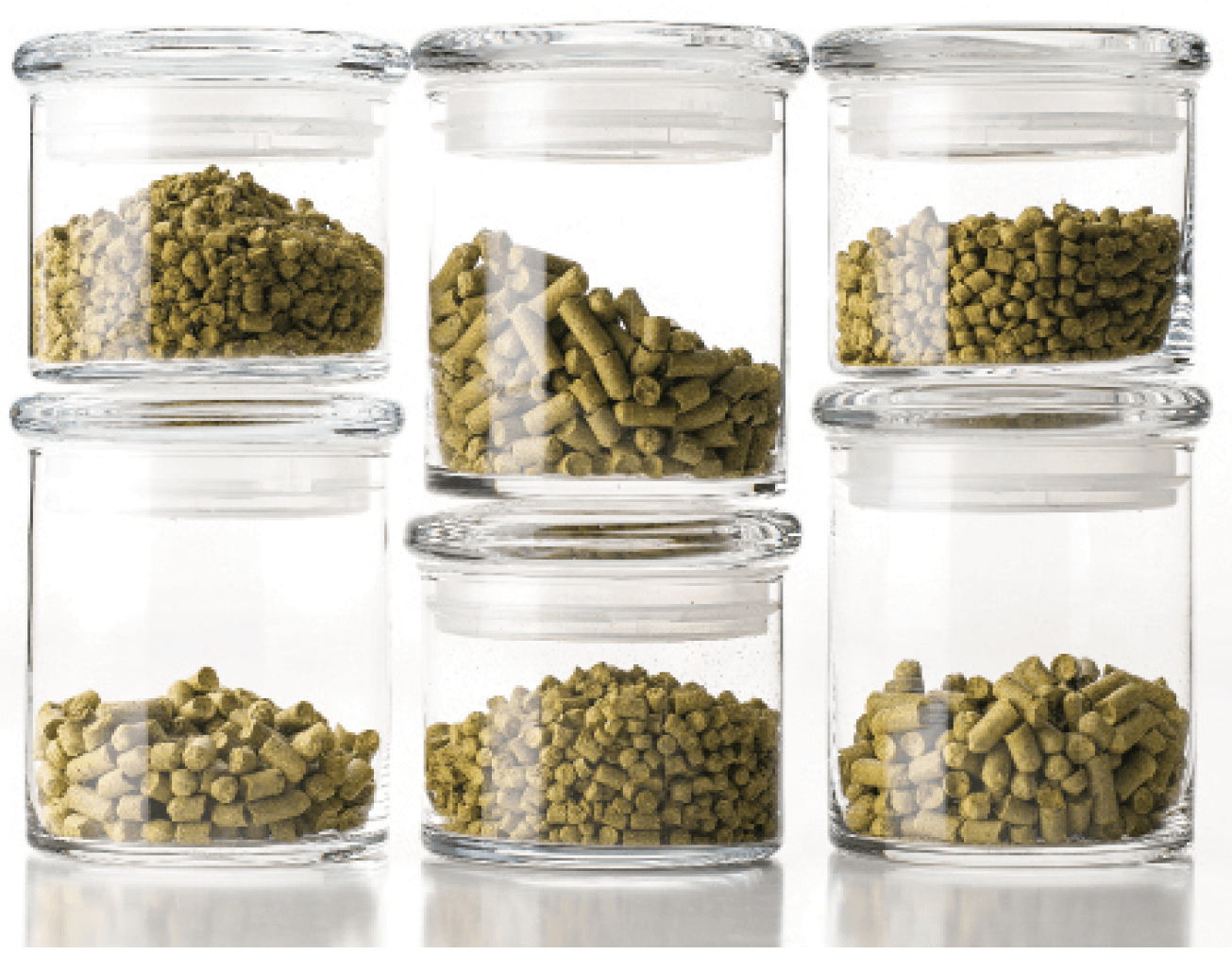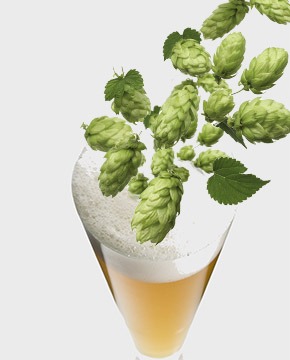Buying & Storing Hops

Whole Hops
Whole hops are simply hop cones that have been picked and dried. Some European hops may also have been sulfured – sulfur sticks were burned in the kiln to give the hops a uniform green appearance. German hops are almost always sulfured. No US hops are. Whole hops, or cone hops, are sometimes erroneously called leaf hops, although the leaves of the hop plant are not used in brewing.
Whole hops are only lightly processed and this appeals to some brewers. When boiled, whole hops float on top of the wort and it is easy to siphon clear wort out from underneath them after the boil. When brewing with a kettle with a spigot at the bottom, a screen at the bottom of the kettle may be employed to keep the hops from exiting the kettle.
In storage, the lupulin glands of whole hops are exposed and will oxidize faster than pellet or plug hops when exposed to oxygen. Under optimal storage conditions, however, the difference is minimal.
Many homebrewers grow their own hops. However, measuring the alpha acid level in them requires laboratory analysis and equipment beyond that found in a typical homebrewery. However, hop producers, larger breweries and some independent laboratories routinely measure the alpha acid level of hops and the corresponding bittering in beer. For a fee, it is possible to send samples to these labs for precise analysis.
Hop Plugs
Hop plugs are made from whole hops, cut into small pieces and pressed into half-ounce (14 g) disks. As with T-90 hop pellets (discussed below), they contain all the material of the whole hops. Unlike hop pellets, the material in hop plugs will float once the plug breaks apart in the kettle.
Pellet Hops
Pellet hops are whole hops that have been finely milled and extruded through a die. Pellets are widely used by homebrewers and commercial brewers because they are more compact and have better storage characteristics when storage conditions are not optimal. Pellet hops also show about 10% better hop utilization than whole hops.
In the kettle, pellets sink to the bottom of the vessel. (They also sink when used as dry hops.) As such, whirlpooling your wort – stirring it in a circular motion, then letting the debris settle in the middle of the kettle – is advised before racking the wort to your fermenter.
The kind of pellets homebrewers are familiar with are T-90 pellets. These pellets contain everything that whole hops contain – both lupulin gland material and vegetative matter. As such, the alpha acid rating of these pellet hops will be the same as (or very close to) alpha acid rating of the whole hops they were made from.
T-45 pellets are hop pellets made such that about half of the vegetative matter is removed, thus roughly doubling the alpha acid percentage of the pellet. Brewers wishing to brew highly bitter beer, but minimize the amount of vegetative matter in their kettle should consider T-45 pellets. Unfortunately, they are not commonly available to homebrewers.
Other Forms
Commercial brewers also have access to hop extracts, isomerized hop extracts and hop oil extracts, and some homebrew shops sell these repackaged into homebrew-friendly sizes.
Evaluating
When buying hops, you should search out those that look green, not brown. In addition, hops should smell fresh, not cheesy. A standard way of evaluating hop aroma is to take whole hops in your hands, rub them together briskly three or four times, then quickly put your nose right down in the sample and smell it. The rubbing ruptures the lupulin glands and releases their aroma. (You may have seen Jim Koch do this on Sam Adams commercials.)
At your homebrew shop, hops should be stored frozen and packaged in oxygen barrier bags. THop resins are somewhat unstable and prone to oxidation, and the alpha acid level of hops decreases over time. This loss is decreased at lower temperatures, and when hops are shielded from exposure to oxygen. The storage stability also varies with the variety of hops. Some varieties will lose more than 50 percent of alpha acids if stored for a year at room temperature; the loss is less than 15 percent if stored at 0 °F (-18 °C). Of course, you will not be able to smell the aroma of frozen and properly bagged hops until you open the package.
Storing at Home
Hops should be stored in your freezer at home until it is time to use them. If you are going to use the hops within a few months, an ordinary frost-free freezer – like that found in almost all home refrigerators – is fine. (For short term storage, up to a couple weeks, your refigerator is fine.)
For long-term storage, hops should be placed in non frost-free freezer. Frost-free freezers remain free of frost because they go through freeze-thaw cycles. Most of the time, the temperature in the freezer is below freezing. However, for short periods of time – long enough to keep frost from forming – they are not. If you are storing your hops for 6 months or so, they would be better off permanently frozen. In this state, they can last for years. The alpha acids will still degrade over time, but the hops will still smell good and be suitable for brewing.
If you don’t have a frost-free freezer, you can package the hops to minimize the effects of the freeze-thaw cycles. Take a small cooler or large ziplock bag and place a layer of crushed ice in it. Pack your hops – inside their oxygen barrier bags – on top of the ice and then cover them with more crushed ice. A buffer of ice between the hops and the environment of the freezer will keep the hops at a more steady temperature. (After a while in storage, you may need a hammer to crack through the ice to get to your hops.)
Some homebrewers buy their hops in bulk late in the year after the harvest comes in. (If you plan to do this, be sure you confirm which year your hops come from.) Big packages of hops should be broken down into smaller packages once opened. Regular plastic ziplock bags are oxygen permeable. If you’re stuck with this as your only option, double bag your hops to minimize exposure to oxygen. Alternately, you can bag the hops and place all the bags in a sealed canning jar or other container that can be closed completely.
Food sealers, such as Seal-A-Meal or Food saver, are great for repackaging bulk hops into smaller portions. These devices remove most of the oxygen from the portion, then seal the bag. The bags themselves can be stored in a large canning jar.



